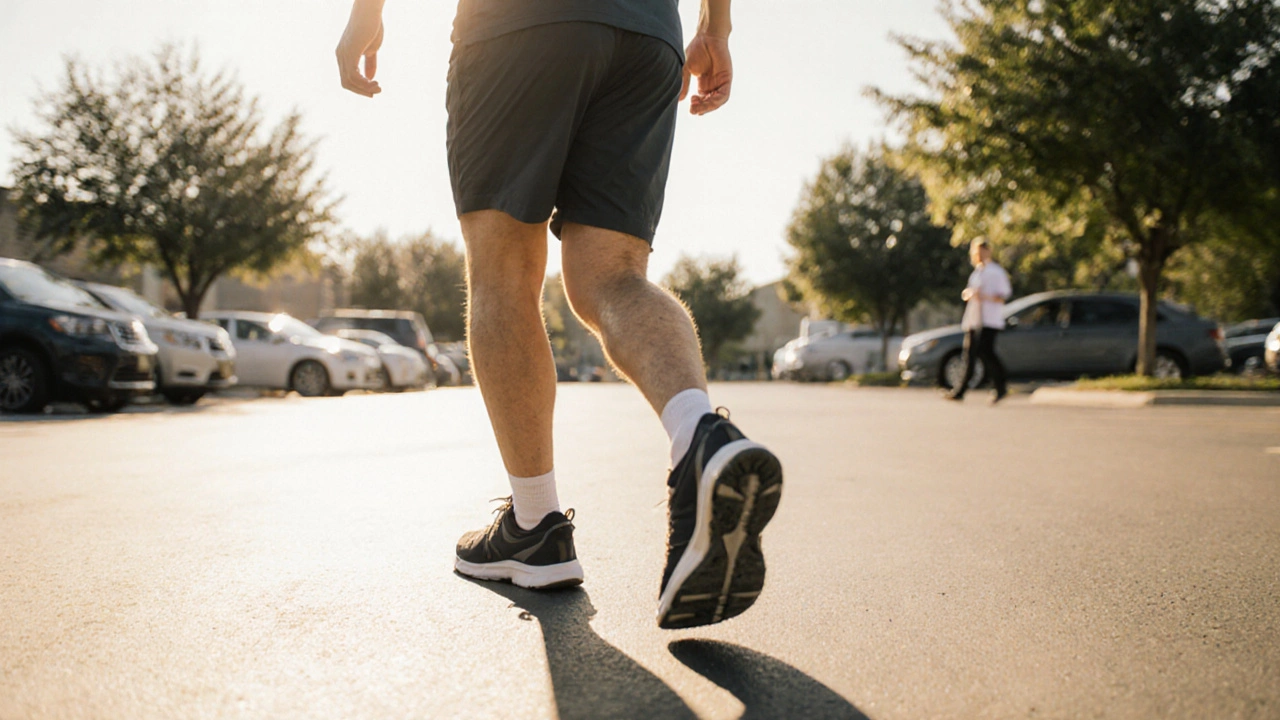
Knee Replacement Walking Timeline Calculator
Your Expected Walking Recovery Timeline
When you hear the words knee replacement is a surgical procedure that swaps out damaged joint surfaces for a prosthetic implant, the first question most patients ask is: "When will I be able to walk like I used to?" The answer isn’t a single number - it’s a range shaped by your age, health, surgical technique and how rigorously you follow rehab. Below we break down the typical milestones, the factors that speed or slow you down, and practical tips to get you on solid ground as quickly and safely as possible.
Key Takeaways
- Most people achieve independent indoor walking within 2weeks, but full community ambulation often takes 6‑8weeks.
- Early mobilization (within 24hours) and a structured physiotherapy program are the single biggest drivers of a speedy recovery.
- Age, pre‑surgery strength, and the presence of other health issues (e.g., diabetes, obesity) can add 1‑3weeks to the timeline.
- Common setbacks - swelling, pain spikes, or a minor loss of range of motion - are usually manageable with simple home strategies.
- Know the red‑flag signs (persistent cramps, deep‑vein clot symptoms, sudden instability) that require immediate medical attention.
Typical Walking Timeline After Knee Replacement
Below is a week‑by‑week snapshot of what most surgeons and physiotherapists expect. Your personal experience may vary, but the milestones give a realistic roadmap.
| Time Post‑Surgery | Walking Goal | Typical Support Needed |
|---|---|---|
| Day 0‑2 | First assisted steps (bed to chair, short hallway) | Walker or crutches, weight‑bearing as tolerated |
| Week 1 | Indoor ambulation without aid for short distances (10‑15m) | Possibly a cane for balance |
| Weeks 2‑3 | Unaided indoor walking; start using stairs with rail | Occasional cane if confidence low |
| Weeks 4‑6 | Community walking (parking lot, short sidewalk)≈30‑50m | Mostly no aid; may use cane on uneven ground |
| Weeks 6‑8 | Normal gait speed (≈1.2m/s) on level surfaces | No aid needed, focus on endurance |
| Month 3+ | Full return to low‑impact activities (swimming, cycling) | None, unless specific sport‑related rehab |

Factors That Influence How Fast You Walk Again
Understanding the variables helps you set realistic expectations and target the right actions.
- Age and Pre‑operative Fitness: A 55‑year‑old with good quadriceps strength often hits the 2‑week indoor walking mark, whereas a 75‑year‑old with limited mobility may need 4‑5weeks.
- Surgical Technique: Minimally invasive or computer‑navigated knee arthroplasty tends to cause less tissue trauma, translating into quicker gait recovery.
- Post‑operative Pain Management: Effective multimodal analgesia (regional block + oral NSAIDs) reduces guarding and allows earlier weight‑bearing.
- Physiotherapy Compliance: Structured, daily exercises - especially early range‑of‑motion and strengthening - shave days off the timeline.
- Co‑morbidities: Diabetes, obesity, or chronic heart disease can slow wound healing and increase swelling, delaying comfortable walking.
Essential Rehab Exercises to Accelerate Walking
These movements are typically introduced in the first 48hours and repeated at least three times a day. Consult your physiotherapist for personalized adjustments.
- Ankle Pumps: Flex and point the foot 20 times each to boost circulation and prevent clots.
- Quadriceps Sets: Tighten thigh muscle, hold 5seconds, relax - repeat 10‑15 times.
- Knee Flexion (Heel Slides): Slide heel toward buttocks while lying flat, aiming for 90° flexion by week2.
- Straight‑Leg Raises: Lift operated leg while keeping knee straight, hold 3seconds, repeat 10‑12.
- Partial Weight‑Bearing Steps: With crutches or a walker, place weight on the operated leg for a few seconds, then step forward. Gradually increase duration.
Progression is guided by pain (should stay <4/10) and swelling (no increase after activity). If you notice sharp pain or a sudden spike in swelling, back off and contact your therapist.
When to Use Walking Aids and How to Transition Off Them
A walking aid is a device such as a walker, crutches, or cane that helps support weight and balance during early recovery is common, but lingering dependence can hinder muscle re‑education. Follow this three‑phase approach:
- Phase1 (Days1‑5): Full‑weight bearing with a walker; focus on safety.
- Phase2 (Weeks1‑2): Switch to a single‑point cane on the opposite side of the operated knee; practice short, straight‑line walks.
- Phase3 (Weeks3‑4): Discontinue the cane once you can walk 20m without pain or sway.
Remember: the goal is to challenge balance, not to eliminate it entirely. Walking barefoot on a soft carpet for a few minutes each day can help retrain proprioception.

Red‑Flag Symptoms - When to Call Your Surgeon
Most discomfort is normal, but these signs suggest complications:
- Increasing calf pain, swelling, or warmth - possible deep‑vein thrombosis.
- Sudden sharp pain at rest, especially if accompanied by a feeling of the knee “giving way.”
- Persistent drainage or foul‑smelling wound discharge.
- Fever above 38°C (100.4°F) that lasts more than 24hours.
- Inability to straighten the knee beyond 10° after the first two weeks.
Early detection prevents long‑term setbacks and keeps your walking plan on track.
Tips to Speed Up Your Return to Normal Gait
- Stay hydrated - fluid helps reduce swelling and supports joint lubrication.
- Apply ice for 15minutes, three times a day, especially after therapy sessions.
- Wear compression stockings as prescribed to improve circulation.
- Get 7‑9hours of sleep; growth hormone peaks at night and aids tissue repair.
- Maintain a protein‑rich diet (≈1.2gprotein/kg body weight) to support muscle rebuilding.
- Use a raised pillow under the operated leg while resting to keep the joint from flexing too much.
Frequently Asked Questions
Can I drive a car after knee replacement?
Most surgeons clear patients for driving once they can comfortably perform an emergency stop with the right foot for at least 30meters, typically around 4‑6weeks post‑op. Always check your local licensing regulations.
Is it normal to use a cane for a month?
Yes, especially if you’re over 70 or have balance issues. The cane protects the healing joint while you rebuild strength. Transition off it as soon as you can walk 20m without pain.
What if I’m not walking by week2?
Contact your physiotherapist. Delayed progress often stems from uncontrolled swelling, pain, or fear of weight‑bearing. Adjusting medication, adding gentle compresses, or revisiting the exercise plan usually resolves the issue.
Can I return to running after a knee replacement?
Running is generally discouraged for the first 12months. Low‑impact activities such as swimming, cycling, or elliptical training are safer alternatives while the prosthetic joint settles.
How does obesity affect my walking recovery?
Higher body weight places extra stress on the implant and surrounding soft tissue, often extending the timeline by 1‑2weeks and increasing the risk of wound complications. Weight‑loss programs before surgery are strongly recommended.
Everyone’s journey is unique, but by following the milestones, staying active with guided physiotherapy, and watching for warning signs, you can confidently stride toward a normal gait. Remember, the goal isn’t just to walk - it’s to walk pain‑free and enjoy the activities you love.





Rohan Talvani
I am a manufacturing expert with over 15 years of experience in streamlining production processes and enhancing operational efficiency. My work often takes me into the technical nitty-gritty of production, but I have a keen interest in writing about medicine in India—an intersection of tradition and modern practices that captivates me. I strive to incorporate innovative approaches in everything I do, whether in my professional role or as an author. My passion for writing about health topics stems from a strong belief in knowledge sharing and its potential to bring about positive changes.
view all postsWrite a comment